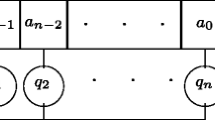Abstract
Watermarking digital media is one of the important challenges for information hiding. Not only the watermark must be resistant to noise and against attempts of modification, legitimate users should not be aware that it is embedded in the media. One of the techniques for watermarking is using an special variant of spread-spectrum technique, called frequency hopping. It requires ensembles of periodic binary sequences with low off-peak autocorrelation and cross-correlation. Unfortunately, they are quite rare and difficult to find. The small Kasami, Kamaletdinov, and Extended Rational Cycle constructions are versatile, because they can also be converted into Costas-like arrays for frequency hopping. We study the implementation of such ensembles using linear feedback shift registers. This permits an efficient generation of sequences and arrays in real time in FPGAs. Such an implementation requires minimal memory usage and permits dynamic updating of sequences or arrays.
The aim of our work was to broaden current knowledge of sets of sequences with low correlation studying their implementation using linear feedback shift registers. A remarkable feature of these families is their similarities in terms of implementation and it may open new way to characterize sequences with low correlation, making it easier to generate them. It also validates a conjecture made by Moreno and Tirkel about arrays constructed using the method of composition.
Supported by Consejería de Universidades e Investigación, Medio Ambiente y Política Social, Gobierno de Cantabria (ref. VP34).
Access this chapter
Tax calculation will be finalised at checkout
Purchases are for personal use only
Similar content being viewed by others
References
Birdsall, T.G., Ristenbatt, M.P.: Introduction to linear shift-register generated sequences. Technical report, The University of Michigan (1958)
Brawley, J.V., Carlitz, L.: Irreducibles and the composed product for polynomials over a finite field. Discrete Math. 65(2), 115–139 (1987). https://doi.org/10.1016/0012-365X(87)90135-X
Ding, C., Hesseseth, T., Shan, W.: On the linear complexity of Legendre sequences. IEEE Trans. Inf. Theory 44(3), 1276–1278 (1998)
Elspas, B.: The theory of autonomous linear sequential networks. IRE Trans. Circ. Theory 6(1), 45–60 (1959)
Games, R.A.: Crosscorrelation of M-sequences and GMW-sequences with the same primitive polynomial. Discrete Appl. Math. 12(2), 139–146 (1985). https://doi.org/10.1016/0166-218x(85)90067-8
Golomb, S.W., Gong, G.: Signal Design For Good Correlation: For Wireless Communication, Cryptography, and Radar. Cambridge University Press, Cambridge (2005)
Gomez-Perez, D., Høholdt, T., Moreno, O., Rubio, I.: Linear complexity for multidimensional arrays-a numerical invariant. In: Proceedings of the IEEE International Symposium on Information Theory (ISIT 2015). IEEE (2015)
Gong, G.: Theory and applications of Q-ary interleaved sequences. IEEE Trans. Inf. Theory 41(2), 400–411 (1995)
Gyorfi, L., Massey, J.L., et al.: Constructions of binary constant-weight cyclic codes and cyclically permutable codes. IEEE Trans. Inf. Theory 38(3), 940–949 (1992)
Kamaletdinov, B.: Optimal sets of binary sequences. Probl. Peredachi Informatsii 32(2), 39–44 (1996)
Kasami, T.: Weight distribution formula for some class of cyclic codes. Coordinated Science Laboratory Report no. R-285 (1966)
Katzenbeisser, S., Petitcolas, F.: Information Hiding Techniques for Steganography and Digital Watermarking. Artech House, Norwood (2000)
Kim, J.H., Song, H.Y.: Trace representation of Legendre sequences. Des. Codes Crypt. 24(3), 343–348 (2001)
Leukhin, A., Tirkel, A.: Ensembles of sequences and arrays. In: 2015 Seventh International Workshop on Signal Design and its Applications in Communications (IWSDA), pp. 5–9. IEEE (2015)
Lidl, R., Niederreiter, H.: Introduction to Finite Fields and Their Applications. Cambridge University Press, Cambridge (1994). https://doi.org/10.1017/CBO9781139172769
Tirkel, A., Gomez-Perez, D., Gomez, A.I.: Arrays composed from the extended rational cycle. Adv. Math. Commun. 11(2), 313–327 (2017)
Tirkel, A., Gomez-Perez, D., Gomez, A.I.: Large families of sequences for CDMA, frequency hopping, and UWB. Cryptogr. Commun. 12(1), 389–403 (2020)
Tirkel, A., Osborne, C., Hall, T.: Steganography-applications of coding theory. In: IEEE Information Theory Workshop, Svalbard, Norway, pp. 57–59 (1997)
Tirkel, A.Z., Hall, T.E.: Matrix construction using cyclic shifts of a column. In: Proceedings of the International Symposium on Information Theory, ISIT 2005, pp. 2050–2054. IEEE (2005)
Tuxanidy, A., Wang, Q.: Composed products and factors of cyclotomic polynomials over finite fields. Designs Codes Cryptogr. 69, 1–29 (2013)
Author information
Authors and Affiliations
Corresponding author
Editor information
Editors and Affiliations
Rights and permissions
Copyright information
© 2021 Springer Nature Switzerland AG
About this paper
Cite this paper
Gomez, A.I., Gomez-Perez, D., Tirkel, A. (2021). Recursion Polynomials of Unfolded Sequences. In: Bajard, J.C., Topuzoğlu, A. (eds) Arithmetic of Finite Fields. WAIFI 2020. Lecture Notes in Computer Science(), vol 12542. Springer, Cham. https://doi.org/10.1007/978-3-030-68869-1_9
Download citation
DOI: https://doi.org/10.1007/978-3-030-68869-1_9
Published:
Publisher Name: Springer, Cham
Print ISBN: 978-3-030-68868-4
Online ISBN: 978-3-030-68869-1
eBook Packages: Computer ScienceComputer Science (R0)



